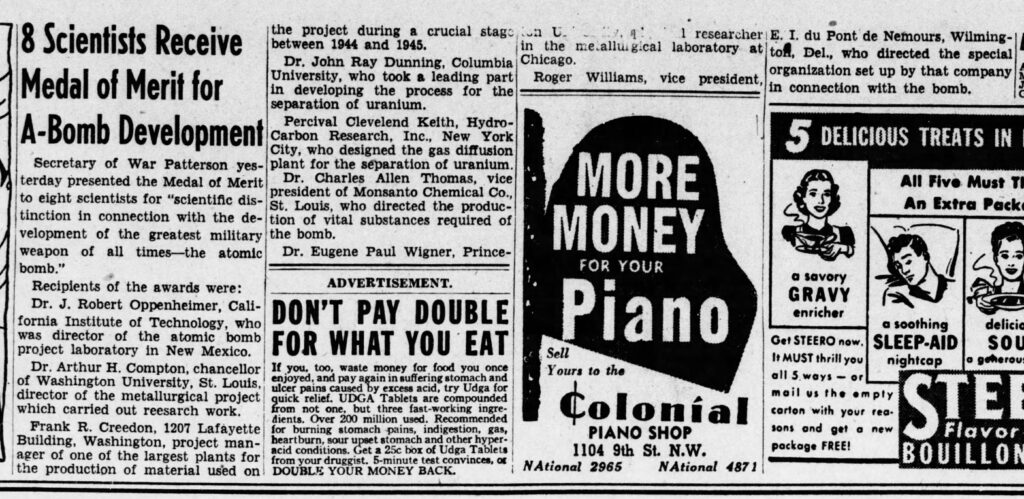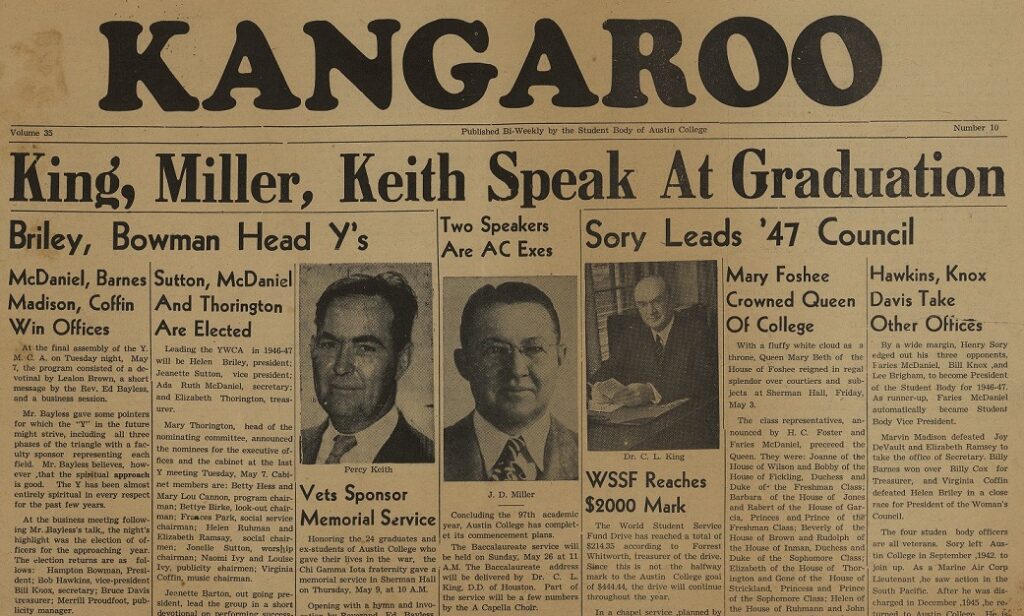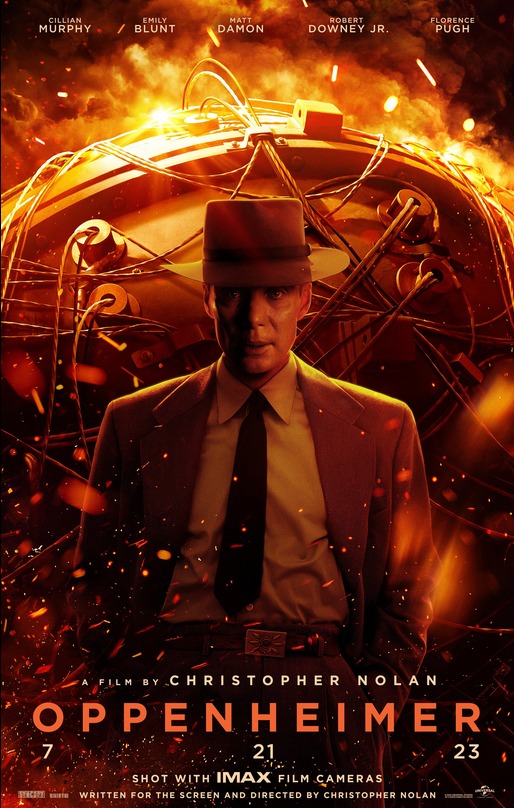
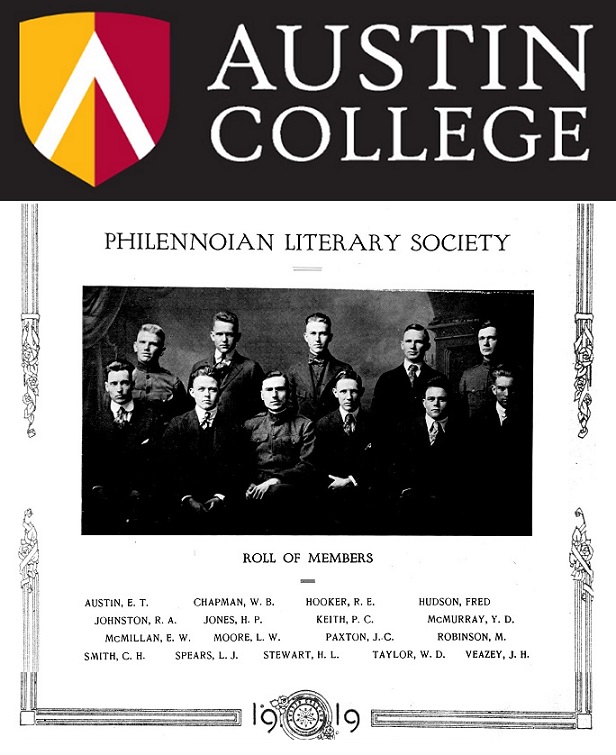
Everything, and I mean EVERYTHING, is a Roo Tale.
Take a look at this photo from the 1919 Austin College yearbook. The members of the Austin College Philennoian Literary Society are pictured here. One of these men was an AC tennis player, champion debater, and English major. But after 1919, his life took a very non-liberal arts turn: he became a scientist.
This Roo got a graduate degree in chemical engineering at MIT and spent two decades pioneering work in the emerging field of energy extraction. After the outbreak of World War 2, he was enlisted in a top-secret American project to develop a new weapon before the Nazis did the same.
During the 1940s, the “Medal for Merit” was the highest civilian decoration awarded by the President of the United States. In 1946, the Harry Truman Administration awarded “Medals for Merit” to eight scientists for “scientific distinction in connection with the development of the atomic bomb.” One of the eight scientists was the Kangaroo pictured in this photo. Another one of the eight was Dr. J. Robert Oppenheimer.
The movie “Oppenheimer” by Director Christopher Nolan will be released on July 23rd. Your Summer Roo Tale homework? Read the “Oppenheimer” Roo Tale over the next six weeks. Then watch the movie at a theatre near you. Hell, come on down to Austin and watch it with me if you want. I’ll point out all of the Roo ties in the movie to you; my non-Roo wife Dianne will appreciate you taking one for the team. 
The “Oppenheimer” Roo Tale will be told in chapters every Saturday up to the movie’s release. Each Saturday chapter will focus on a location along the path to the atomic age, a principal character in Nolan’s movie, and the location & character ties to this amazing Kangaroo. By the time the movie is released, you’ll be prepared for Oppenheimer’s story and ready to look for the references about this Roo in Nolan’s blockbuster movie.
This summer, it’s all about Oppenheimer, the atomic bomb, and somehow, against all odds………a tennis-playing English major who graduated from Austin College. What’s a Roo Tale? Everything. Everything is a Roo Tale.
Saturday, June 10: Introduction
Saturday, June 17: Chicago & Enrico Fermi
Saturday, June 24: MIT & Vannevar Bush
Saturday, July 1: Manhattan & Leslie Groves
Saturday, July 8: Oak Ridge & Ernest Lawrence
Saturday, July 15: Los Alamos & Robert Oppenheimer
Saturday, July 22: “Oppenheimer” Roo Tale
Sunday, July 23: The movie “Oppenheimer” opens nationwide. By then, you’ll be ready to see it!
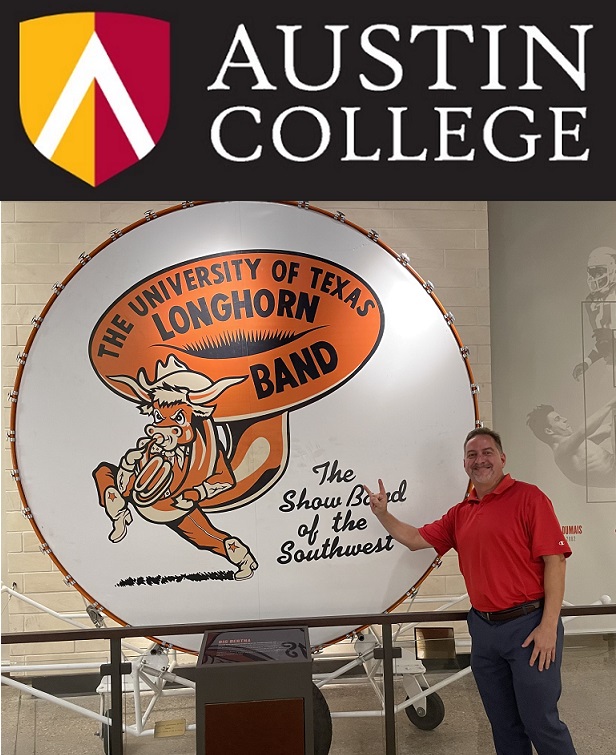
Saturday, June 17. Chapter 1: Chicago & Enrico Fermi
His name was Percival C. Keith. He was an Austin College Kangaroo. And alongside Robert Oppenheimer, he led America into the atomic age.
Our story begins 100 years ago.
In 1923, the Texas Longhorn football team kicked off its season at home against the Kangaroos of Austin College. University of Texas President Robert Vinson, an Austin College graduate, was in attendance at Clark Field on the campus of UT. Vinson was also preoccupied with his pet project that fall: overseeing the construction of a new Longhorn football stadium. DKR Texas Memorial Stadium would open under Vinson’s watch one year later. It is still in use today and houses the University of Texas Athletics Hall of Fame.
In 1923, the University of Chicago football team kicked off its season at home at Stagg Field. Amos Alonzo Stagg’s nationally ranked Maroons won easily, on the way to yet another successful season. That season also included the introduction of “Big Bertha” into the University of Chicago marching band. “Big Bertha” was the largest drum in the world.
The University of Chicago dropped football before World War 2, so Big Bertha was shelved underneath the bleachers at Stagg Field. Those bleachers were an ideal place for nuclear experimentation by University of Chicago professor Enrico Fermi, who constructed his uranium-fueled “Chicago Pile-1” (CP1) in 1942. There, Fermi successfully conducted the world’s first self-sustained nuclear chain reaction; Big Bertha’s proximity to the radiation resulted in a very mild contamination. In 1954, Big Bertha was sold to the University of Texas Longhorn band; rumors of its contamination came with the sale from the University of Chicago.
Enrico Fermi worked closely with Robert Oppenheimer (Cillian Murphy in “Oppenheimer”) in the development of an atomic weapon during World War 2. Austin College Kangaroo Percival C. Keith worked closely with Oppenheimer as well. Fermi & Keith were tasked with providing fuel for Oppenheimer’s weapon at the Oak Ridge National Laboratory in Tennessee. Fermi oversaw the facility’s X-10 Graphite Reactor, which attempted to extract plutonium from natural uranium. Keith oversaw the facility’s K-25 plant, which attempted to extract enriched uranium (uranium-235) from natural uranium. Both would be successful before the war’s end.
Fermi’s X-10 plutonium, extracted from the world’s second self-sustained nuclear chain reaction (after CP1), would fuel Oppenheimer’s July 16, 1945 “Trinity” test. Keith’s enriched uranium, extracted from a revolutionary engineering process he developed, would fuel Oppenheimer’s “little boy” weapon. Enrico Fermi & Percival Keith were partners, collaborators, and competitors at Oak Ridge, overseeing huge facilities, budgets in the billions, and furious work to produce atomic fuel in a race against the Nazis.
Enrico Fermi’s Stagg Field makes a brief appearance in trailer #1 (1:42 mark) and trailer #2 (1:02 mark) of the Christopher Nolan movie “Oppenheimer.” Oppenheimer is seen walking across Stagg Field to find Fermi after being told by General Leslie Groves (Matt Damon in “Oppenheimer”) to “go recruit some scientists.” In addition to Fermi, General Groves also recruited Roo Percival C. Keith. The relationship between Groves and Keith will be a part of the “Manhattan & Leslie Groves” chapter on Saturday, July 1st.
In the movie, the part of Enrico Fermi is played by actor Danny Deferrari. The part of Percival Keith is not cast, likely because Christopher Nolan chose Ernest Lawrence (Josh Harnett in “Oppenheimer”) over Keith to represent America’s father of enriched uranium. Lawrence was a Cal-Berkeley (West Coast) colleague of Oppenheimer; Keith was a member of the MIT (East Coast) contingent of the project. Keith’s connections to MIT will be a part of the “MIT & Vannevar Bush” chapter on Saturday, June 24th.
However, the presence of Keith will be found throughout Nolan’s movie. Clues to look for from this chapter: Fermi, Stagg Field, Chicago Pile-1 (CP1), X-10 vs. K-25, plutonium vs. uranium-235, and Oak Ridge. Keith’s colleague Fermi can be found in trailer #2 (2:26 mark), responding to Oppenheimer’s comment about a bomb ushering in a period of peace with “until someone builds a bigger bomb.”
In Austin, Dianne & I have a little “Supper Club.” The supper club includes our friends Allyson & Mike Fertig, whose daughter Brooke was in the Longhorn band in the fall 2022 when Big Bertha was officially retired after 100 years. Dianne & I attended the game with Mike & Allyson. I took a picture of Dianne & Allyson with Brooke before game time before departing for “Supper Club” later that evening. Joining us at supper club were Leticia & Stephen Marquez, and Laura & James Williams.
Interestingly, our supper club was hosted that evening by our friends Laura & John Hayek. In the 1980s, John was a student at the University of Chicago and played football for the Maroons at the (new) Stagg Field. Over dinner, John told tales of Big Bertha’s Chicago birth in 1923, nuclear contamination by Fermi in the 1940s, and sale to the Longhorns in the 1950s. Thanks to Roo Percival C. Keith, that Big Bertha / Supper Club evening is now a chapter in a Roo Tale.
Today, Big Bertha sits in the University of Texas Athletics Hall of Fame at DKR Texas Memorial Stadium, the stadium built by Roo Robert Vinson. For this Percival C. Keith chapter, I paid a quick visit and took a picture alongside Big Bertha. No sign of Enrico Fermi radiation poisoning so far; I feel fine.
Next Saturday’s chapter will focus on Percival Keith’s time at the Massachusetts Institute of Technology (MIT). Keith left Austin College in 1919 for MIT, where he would befriend an engineering professor named Dr. Vannevar Bush (Matthew Modine in “Oppenheimer”). After Pearl Harbor, Dr. Bush was selected by President Franklin D. Roosevelt as his right-hand man to beat the Nazis to an atomic weapon. Keith would be right by his side.
The movie “Oppenheimer” by Director Christopher Nolan will be released on July 23rd. Your Summer Roo Tale homework? Keep reading this “Oppenheimer” Roo Tale. Then watch the movie at a theatre near you. And remember: the Harry Truman Administration awarded “Medals for Merit” to eight scientists for “scientific distinction in connection with the development of the atomic bomb.” One of the eight scientists was Austin College Kangaroo Percival C. Keith. Another one of the eight was Dr. J. Robert Oppenheimer.
Saturday, June 10: Introduction
Saturday, June 17: Chicago & Enrico Fermi
Saturday, June 24: MIT & Vannevar Bush
Saturday, July 1: Manhattan & Leslie Groves
Saturday, July 8: Oak Ridge & Ernest Lawrence
Saturday, July 15: Los Alamos & Robert Oppenheimer
Saturday, July 22: The Percival C. Keith “Oppenheimer” Roo Tale
Sunday, July 23: The movie “Oppenheimer” opens nationwide. Go see it!
https://news.uchicago.edu/explainer/first-nuclear-reactor-explained
https://www.atlasobscura.com/places/big-bertha-drum
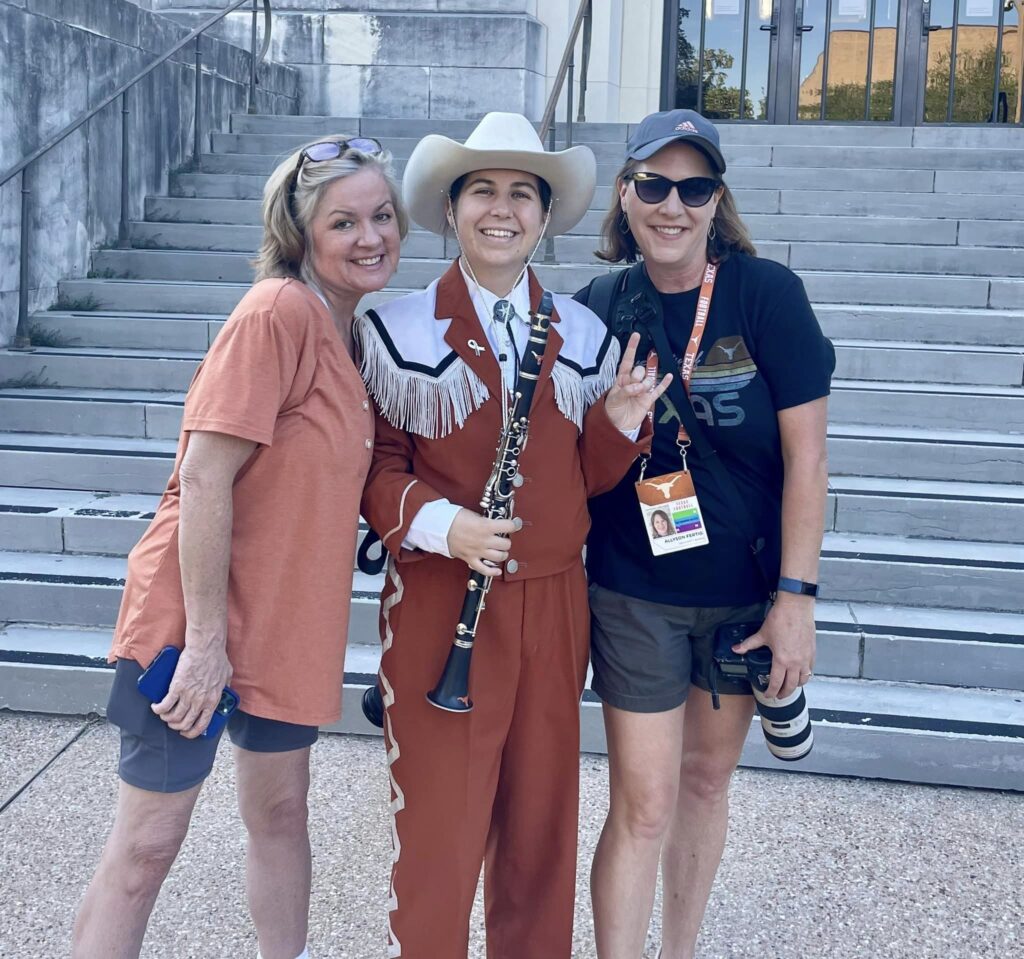
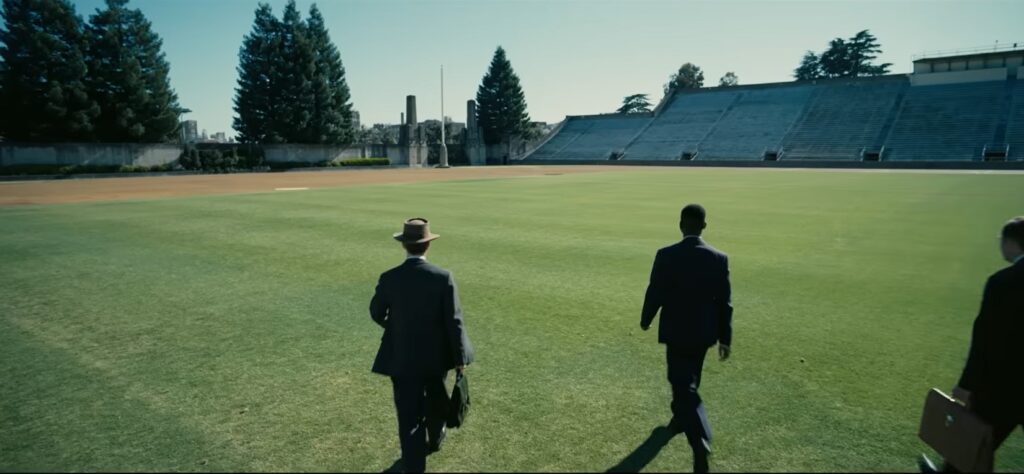
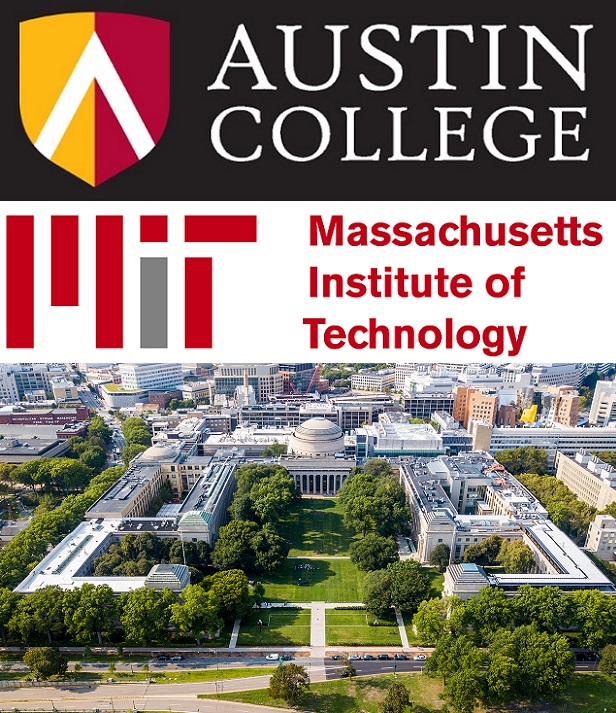
Saturday, June 24: Chapter 2: MIT & Vannevar Bush
His name was Percival C. Keith. He was an Austin College Kangaroo. And alongside Robert Oppenheimer, he led America into the atomic age.
Dr. Vannevar Bush & I have one thing in common. We both took a trip from Tufts to MIT.
I was a grad student at Tufts University (Medford, MA) in 1994, studying at the Fletcher School of International Affairs. The State Department administered the U.S. Foreign Service exam that year at the Massachusetts Institute of Technology (MIT), so my buds and I headed south for the test. We woke up early, boarded the red line at Davis Square, and traveled four stops to the MIT station. There, we entered the grand halls of MIT and attempted to pass an exam required for those interested in a career in the diplomatic service.
Dr. Vannevar Bush was an undergrad at Tufts University in 1913, graduating with a Bachelor of Science degree. After graduate work at MIT, Bush was hired to become an MIT faculty member in the Department of Electrical Engineer in 1919. One MIT grad student in particular caught Bush’s interest: a young Texan named Percival C. Keith, who had graduated with an English degree from Austin College in 1919.
According to a bio of Percival Keith, “[Keith] entered Massachusetts Institute of Technology (MIT) in 1919 and spent three exciting years there taking all the courses he could manage in mathematics, chemistry, and engineering. It was at MIT that Percival Keith acquired the nickname ‘Dobie,’ which he was called for the rest of his life.” Keith bonded closely with two MIT faculty members who would be associated with America’s entry into the atomic age: Dr. Warren K. Lewis & Dr. Vannevar Bush.
Following his years at MIT, Bush moved to Washington, D.C. His primary mission became increased cooperation between the American scientific community and the U.S. military. After the Nazi invasion of Poland in 1939, Bush proposed to President Franklin Roosevelt the creation of a new agency to facilitate that cooperation. FDR granted his approval; the new agency would eventually become the “Office of Scientific Research and Development (OSRD).” A contemporary of Bush remarked that “of the men whose death in the Summer of 1940 would have been the greatest calamity for America, the President is first, and Dr. Bush would be second or third.”
Dr. Bush went looking for scientific minds to fill the OSRD planning board, and soon came calling on his former student Percival Keith. After MIT, Keith had spent years in private practice perfecting the energy extraction methods which would be vital for one of the OSRD’s priorities: a project codenamed “S-1.” Keith was asked to join the board and accepted. He would spend the next 5 years working closely with Bush and others in the cast of Christopher Nolan’s movie “Oppenheimer,” to be released in July.
The part of Dr. Vannevar Bush in “Oppenheimer” is played by Matthew Modine (Vision Quest, Full Metal Jacket, And the Band Played On, Stranger Things). The part of Percival Keith is not cast, likely because Christopher Nolan chose Ernest Lawrence (Josh Harnett in “Oppenheimer”) over Keith to represent America’s father of enriched uranium. Keith’s ties to Lawrence will be a part of the July 8th chapter “Oak Ridge & Ernest Lawrence.”
However, the presence of Keith will be found throughout Nolan’s movie. Clues to look for from this chapter: MIT, Vannevar Bush, Warren K. Lewis, Washington, FDR, OSRD, and S-1. Keith’s colleague Bush is not found in any of the two Oppenheimer trailers released to date. But he will nevertheless be a significant part of the film because of his role as chief of Roosevelt’s OSRD, an agency which included Roo Percival Keith.
Next Saturday’s “Oppenheimer” Roo Tale is titled “Manhattan & Leslie Groves.” Bush hired Lt. General Groves (Matt Damon in “Oppenheimer”) to lead the OSRD project “S-1.” After his appointment, Groves met with Percival Keith near Keith’s Manhattan office to discuss the obstacles they would face. They walked up and down the streets of Manhattan talking about S-1, as oblivious New Yorkers passed them by. Groves would later set up S-1 headquarters in a building just a few blocks from Keith’s downtown Manhattan office. Because of the office locations, the S-1 project would be informally renamed the “Manhattan Project.”
I passed the United States Foreign Service exam back in 1994, when I took the test at MIT. I eventually chose a career in information technology (I.T.), a profession I’ve enjoyed for 25 years. But who knows? Career #2 might very well be the foreign service. However, I’ve always enjoyed the fact that a high point of my academic career was a trip from Tufts to MIT to pass the foreign service exam. And while writing this chapter, I learned something even neater. The MIT building where I passed that exam has a name: the Vannevar Bush Building.
The movie “Oppenheimer” by Director Christopher Nolan will be released on July 23rd. Your Summer Roo Tale homework? Keep reading this “Oppenheimer” Roo Tale. Then watch the movie at a theatre near you. And remember: the Harry Truman Administration awarded “Medals for Merit” to eight scientists for “scientific distinction in connection with the development of the atomic bomb.” One of the eight scientists was Austin College Kangaroo Percival C. Keith. Another one of the eight was Dr. J. Robert Oppenheimer.
Saturday, June 10: Introduction
Saturday, June 17: Chicago & Enrico Fermi
Saturday, June 24: MIT & Vannevar Bush
Saturday, July 1: Manhattan & Leslie Groves
Saturday, July 8: Oak Ridge & Ernest Lawrence
Saturday, July 15: Los Alamos & Robert Oppenheimer
Saturday, July 22: The Percival C. Keith “Oppenheimer” Roo Tale
Sunday, July 23: The movie “Oppenheimer” opens nationwide. Go see it!
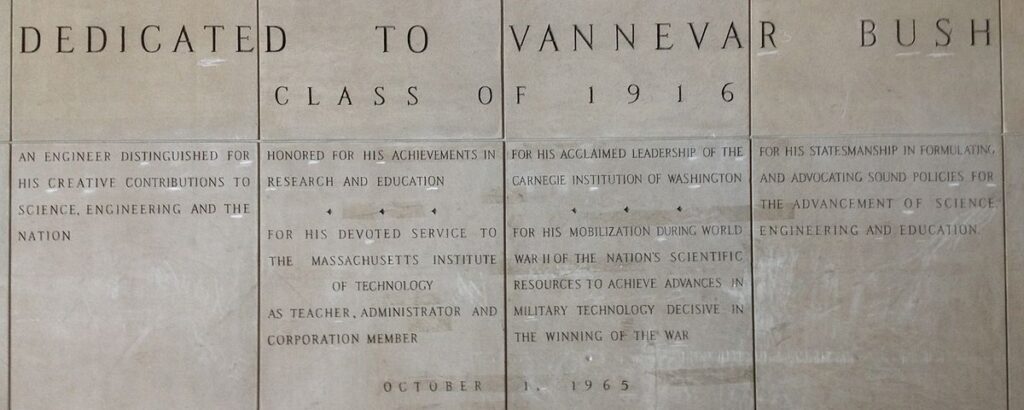
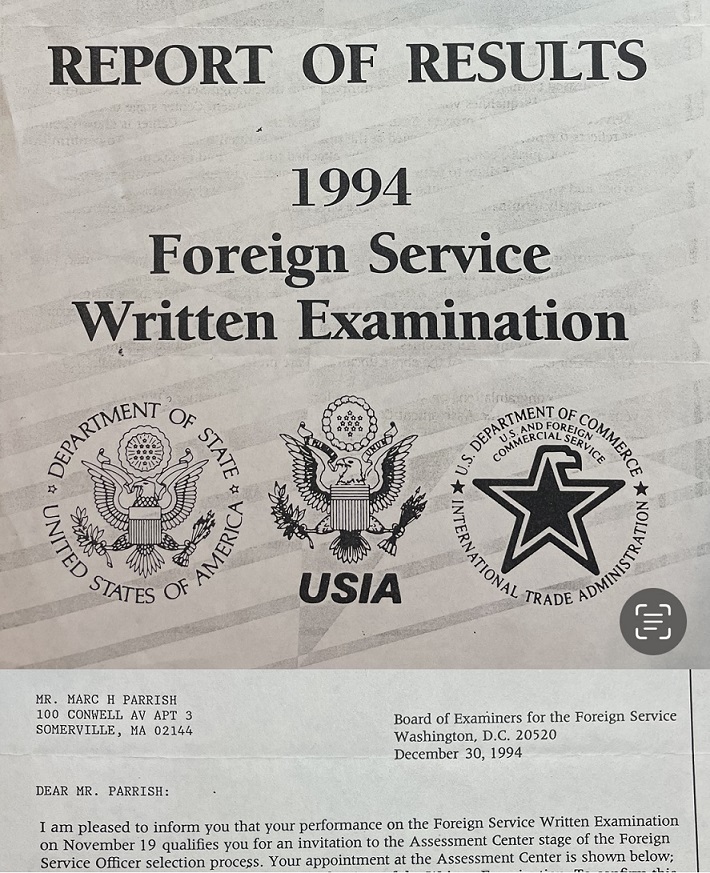
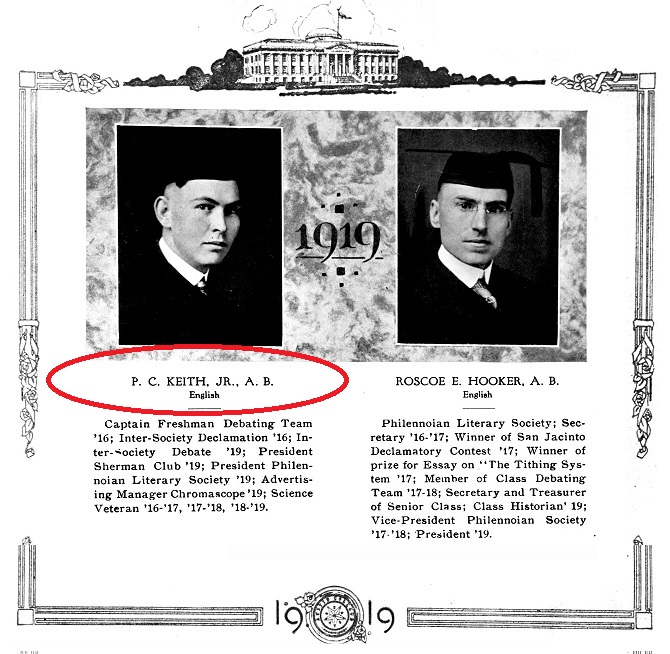
https://historynewsnetwork.org/article/176129
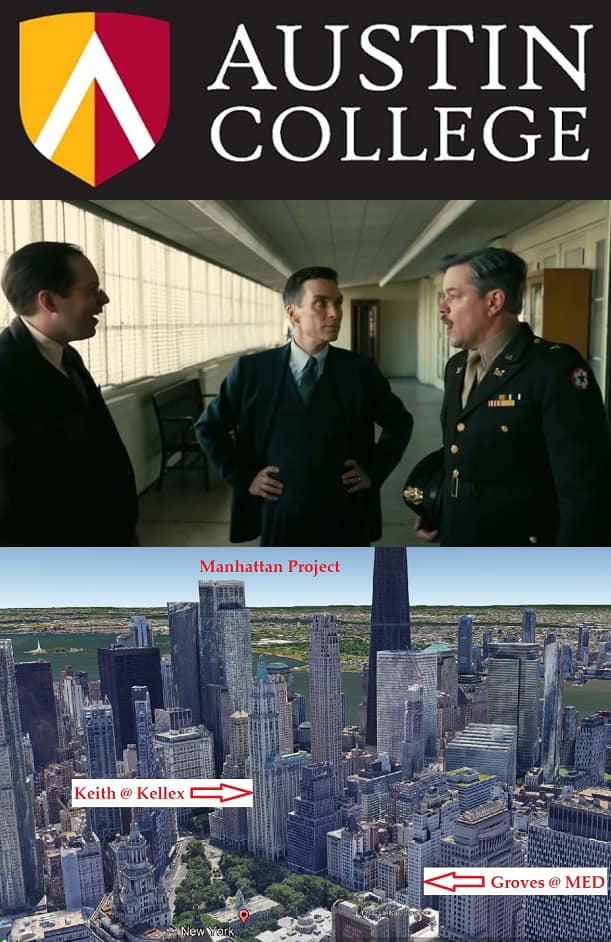
Saturday, July 1: Chapter 3: Manhattan & Leslie Groves
His name was Percival C. Keith. He was an Austin College Kangaroo. And alongside Robert Oppenheimer, he led America into the atomic age.
It all got started in Manhattan.
OSRD Director Vannevar Bush felt his project to develop an atomic weapon needed more “aggressive leadership.” To lead the effort, Bush appointed Brigadier General Leslie Groves (Matt Damon in “Oppenheimer”) to lead the effort. Groves established the project’s headquarters in 1942 at 270 Broadway in New York City. He named the project the “Manhattan Engineering District (MED);” the name would later be informally shortened to the “Manhattan Project.”
Los Alamos is the site where Oppenheimer and his team designed and tested the atomic bomb. But the weapon relied upon fuel which did not yet exist in 1942. That fuel had been discovered in 1935: it was enriched uranium (uranium-235), an extremely energy dense component of natural uranium. Uranium-235 quantities were tiny (only 1% of natural uranium) and almost chemically identical to natural uranium. The Manhattan project knew uranium-235 was in there; their challenge was how to get it. Over 90% of the operating budget of the Manhattan Project was devoted to this endeavor. Less than 10% was spent at Los Alamos.
Groves recruited Roo Percival C. Keith to figure out how to get the U-235. Keith was recommended to Groves by Dr. Vannevar Bush, Keith’s former MIT professor and fellow OSRD S-1 (“Manhattan Project”) board member. Keith was also not hard for Groves to find; he was a top engineer for the Kellogg Corporation at the Woolworth Building at 233 Broadway, just three blocks south of the MED headquarters in Manhattan. In 1942, Groves & Keith concluded that a special plant would need to be built for the extraction. They agreed upon a site: Oak Ridge, TN. Keith was interviewed in 1965 about his relationship with Grove and the early days of the Manhattan Project:
Keith: “So I decided I would accept the job of trying to build this plant at Oak Ridge. [Leslie] Groves came up from Washington, and he and I went out to dinner [in Manhattan]. This little restaurant was on 58th street, just east of 5th Avenue. After dinner, he wanted to walk for a while. [We] walked up 58th and down 57th and up 57th and down 58th.”
Keith: “He told me more or less his life history, [how he was called in] and said that he had been given this job by the President, Mr. Roosevelt. I was talking about the steps that I might take, what I thought was logical without taking much gamble. I remember very distinctly that his plea to me was that we had to go at this all out. I promised him that we would do everything that we could to do that.”
Groves and Keith set up a fictitious corporation to attempt the extraction of uranium-235. The corporation was named “Kellex,” a combination of “Kellogg” and “X” (for “secret”). The two also agreed that Oak Ridge, TN was an ideal location for Kellex and its mission, as it was far from international borders, natural disasters, and poor climates. Keith’s home for the duration of the war was the K-25 plant at Oak Ridge, overseeing a herculean effort to produce the fuel for Oppenheimer’s weapon. That effort will be part of the July 8th Chapter “Oak Ridge & Ernest Lawrence.”
In 1965, Groves was interviewed about his relationship with Roo Percival C. Keith and Keith’s effort at the K-25 plant at Oak Ridge:
Groves: “Well, of course to me it was Keith [who gets the credit] because he was the head [of K-25]. And while you probably heard a great deal from the scientific people, it was Keith that was responsible [for the success]. He had a drive and a willingness to make a decision instead of saying well maybe we can get something better around the corner. They [all] did a great job and it was all due to Keith.”
Groves: “But I think on Keith, the big thing that he had was just what he has got today: this enthusiasm and a tremendous capacity for understanding scientific engineering. He had been in it all his life, so he had many things at his fingertips that the average engineer would have [missed]. You had go-getters there [at Oak Ridge], like [Ernest] Lawrence [in Y-12]. You had Keith in K-25.”
The part of Lt. General Leslie Groves in “Oppenheimer” is played by Matt Damon. The part of Percival Keith is not cast, likely because Christopher Nolan chose Ernest Lawrence (Josh Harnett in “Oppenheimer”) over Keith to represent America’s father of enriched uranium. The Lawrence method of extracting uranium-235 [in plant Y-12] existed in 1942 but was terribly inefficient; Keith developed a new, more efficient process [in plant K-25] which made up for the Lawrence shortfall andensured enough American enriched uranium by 1945. Keith’s ties to Lawrence will be a part of the July 8th chapter “Oak Ridge & Ernest Lawrence.”
Despite not being cast, the presence of Keith will neverthelessbe found throughout Nolan’s movie. Clues to look for from this chapter: Manhattan Engineering District (MED), Leslie Groves, Woolworth building, Kellogg, Kellex, Oak Ridge, Y-12, & K-25. Keith’s boss Leslie Groves (Matt Damon) is found throughout Trailer #2 of the movie “Oppenheimer.” At the 1:00 mark, Groves exclaims “let’s go recruit some scientists” for the Manhattan Project. One of those scientists was Roo Percival Keith, recruited while walking with Groves on the streets of Manhattan. Together, they decided to “go at this all out” to beat the Nazis in (what Damon calls in trailer #1) “the most important thing to ever happen in the history of the world.”
The movie “Oppenheimer” by Director Christopher Nolan will be released on July 23rd. Your Summer Roo Tale homework? Keep reading this “Oppenheimer” Roo Tale. Then watch the movie at a theatre near you. And remember: the Harry Truman Administration awarded “Medals for Merit” to eight scientists for “scientific distinction in connection with the development of the atomic bomb.” One of the eight scientists was Austin College Kangaroo Percival C. Keith. Another one of the eight was Dr. J. Robert Oppenheimer.
Saturday, June 10: Introduction
Saturday, June 17: Chicago & Enrico Fermi
Saturday, June 24: MIT & Vannevar Bush
Saturday, July 1: Manhattan & Leslie Groves
Saturday, July 8: Oak Ridge & Ernest Lawrence
Saturday, July 15: Los Alamos & Robert Oppenheimer
Saturday, July 22: The Percival C. Keith “Oppenheimer” Roo Tale
Sunday, July 23: The movie “Oppenheimer” opens nationwide. Go see it!
https://en.wikipedia.org/wiki/Kellex_Corporation
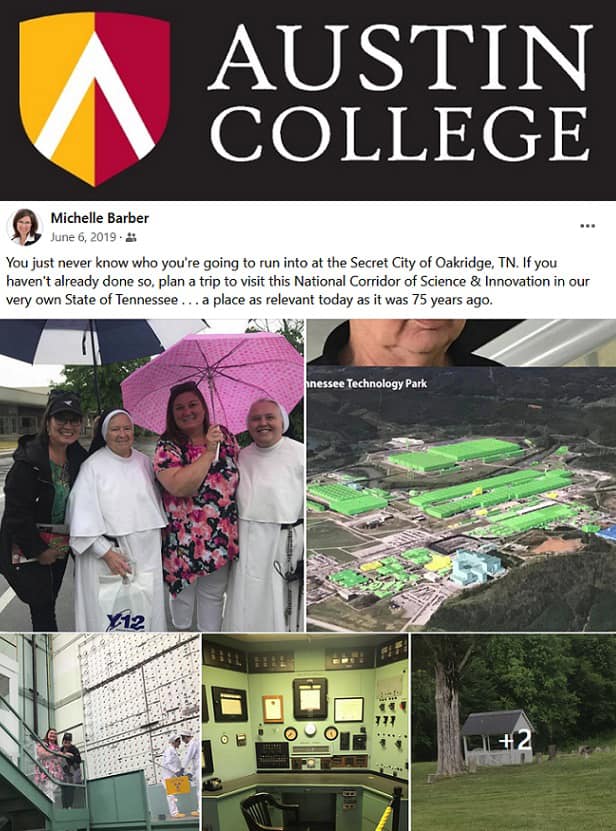
Saturday, July 8. Chapter 4: Oak Ridge & Ernest Lawrence
His name was Percival C. Keith. He was an Austin College Kangaroo. And alongside Robert Oppenheimer, he led America into the atomic age.
Austin College Kangaroo (and Tennessee native) Michelle Barber visited Oak Ridge, TN in 2019. Michelle wrote “If you haven’t already done so, plan a trip to visit the National Corridor of Science & Innovation in our very own state of Tennessee…a place as relevant today as it was 75 years ago.”
Over 75 years ago, Oak Ridge, TN was just a small town near Knoxville hidden in the Appalachian Mountains. But the demands of the atomic age brought Oak Ridge into the limelight. The Manhattan Project needed an ideal place to extract enriched uranium and settled on Oak Ridge. The town was far from international borders, which meant protection from Nazi & Japanese attack. Its climate was temperate, which reduced production disruptions. Oak Ridge sat in a rural area in the event of a radiation disaster yet was close enough to urban Knoxville to attract a much-needed work force.
But most importantly, Oak Ridge was located next to a huge river in the Tennessee Valley, which would be able to provide the enormous amounts of electrical power which would be needed to extract enriched uranium.
Enriched uranium (uranium-235) only comprised 1% of natural uranium. But it was “the good stuff,” the incredibly energy dense component which would power the nuclear age. It would have been nice to extract it like one slices a birthday cake. But uranium-235’s similar weight & composition made that impossible. The scientific community knew it was in there yet had no idea how to remove it. But two Americans figured it out: Ernest Lawrence (Josh Harnett in “Oppenheimer”) & Kangaroo Percival C. Keith.
Lawrence’s “electromagnetic” method existed in 1942 and was immediately put to use in Oak Ridge. A Lawrence electromagnetic plant was built and informally named after its World War II code name “Y-12.” The process, however, was terrible inefficient. Enormous amounts of human and electrical power at a cost of billions of dollars were employed, yet most of the extracted uranium-235 was lost to these inefficiencies. Roughly 100 pounds of uranium-235 was needed for a weapon, yet Lawrence’s Y-12 was only able to churn out about one pound per month. It would not be enough.
Manhattan Project Director Leslie Groves (Matt Damon in “Oppenheimer”) needed something better, and asked Percival Keith if he had any ideas. Keith did. Keith believed in an idea he had conceived called “gaseous diffusion.”
Because of the slight differences in weight between enriched & natural uranium, Keith was certain that uranium-235 could be extracted by gassing the element at high pressures and separating the two components via filtering. The big problems, however, were finding the right equipment, the right mixtures, and massively scaling a proven process. From 1942 to 1944, huge amounts of money and work hours under Keith’s direction were spent inventing and testing the right compressors, pumps, and barriers (filters). Once successfully tested, Keith realized that the gaseous diffusion process would need thousands of filtering iterations to produce sufficiently enriched uranium. And that meant a need to build the largest plant in the world.
That plant would also be located at Oak Ridge and would be informally named after its World War II code name “K-25.” When completed in 1944, K-25 was the world’s largest building, comprising over 5 million square feet.
In 1944, Lawrence’s Y-12 was still woefully short of the amount of uranium-235 needed to fuel a weapon. But Keith’s K-25 plant began to rapidly make up the shortfall as 1944 turned to 1945. By July of 1945, when Oppenheimer’s successful Trinity test took place near Los Alamos, Lawrence had produced 60% of the uranium-235 needed for the “little boy” weapon. In a very short time span, Keith supplied nearly all of the remaining 40%.
The part of Ernest Lawrence in “Oppenheimer” is played by Josh Harnett. The part of Percival Keith is not cast, likely because Christopher Nolan chose Ernest Lawrence over Keith to represent America’s father of enriched uranium. But make no mistake, Keith was as indispensable as Lawrence for supplying the fuel needed for Oppenheimer’s weapon developed at Los Alamos, New Mexico. Keith’s ties to Robert Oppenheimer will be a part of the July 15th chapter “Los Alamos & Robert Oppenheimer.”
Despite not being cast, the presence of Keith will nevertheless be found throughout Nolan’s movie. Clues to look for from this chapter: Oak Ridge, Ernest Lawrence, electromagnetic vs. gaseous diffusion, Y-12 vs. K-25, compressors, pumps, barriers (filters), and uranium-235 (U-235). Most of the movie will likely focus on Robert Oppenheimer (Cillian Murphy in “Oppenheimer) and his design, development, of the “gadget” at Los Alamos. Percival Keith, however, also has strong ties to Oppenheimer and Los Alamos; those ties will be part of the July 15th chapter “Los Alamos & Robert Oppenheimer.”
Michelle Barber is probably reading this now and shaking her head. She was indeed correct when she visited that Oak Ridge was “a place as relevant today as it was 75 years ago.” In her post, Michelle shared a picture of the K-25 plant at Oak Ridge, the brainchild of Percival C. Keith in his attempt to extract atomic fuel before Adolf Hitler did the same. How could she have known that she was visiting the handiwork of an Austin College Kangaroo? Yes Michelle, there are Roo ties everywhere.
The movie “Oppenheimer” by Director Christopher Nolan will be released on July 23rd. Your Summer Roo Tale homework? Keep reading this “Oppenheimer” Roo Tale. Then watch the movie at a theatre near you. And remember: the Harry Truman Administration awarded “Medals for Merit” to eight scientists for “scientific distinction in connection with the development of the atomic bomb.” One of the eight scientists was Austin College Kangaroo Percival C. Keith. Another one of the eight was Dr. J. Robert Oppenheimer.
Saturday, June 10: Introduction
Saturday, June 17: Chicago & Enrico Fermi
Saturday, June 24: MIT & Vannevar Bush
Saturday, July 1: Manhattan & Leslie Groves
Saturday, July 8: Oak Ridge & Ernest Lawrence
Saturday, July 15: Los Alamos & Robert Oppenheimer
Saturday, July 22: The Percival C. Keith “Oppenheimer” Roo Tale
Sunday, July 23: The movie “Oppenheimer” opens nationwide. Go see it!
https://en.wikipedia.org/wiki/Y-12_National_Security_Complex
https://en.wikipedia.org/wiki/K-25
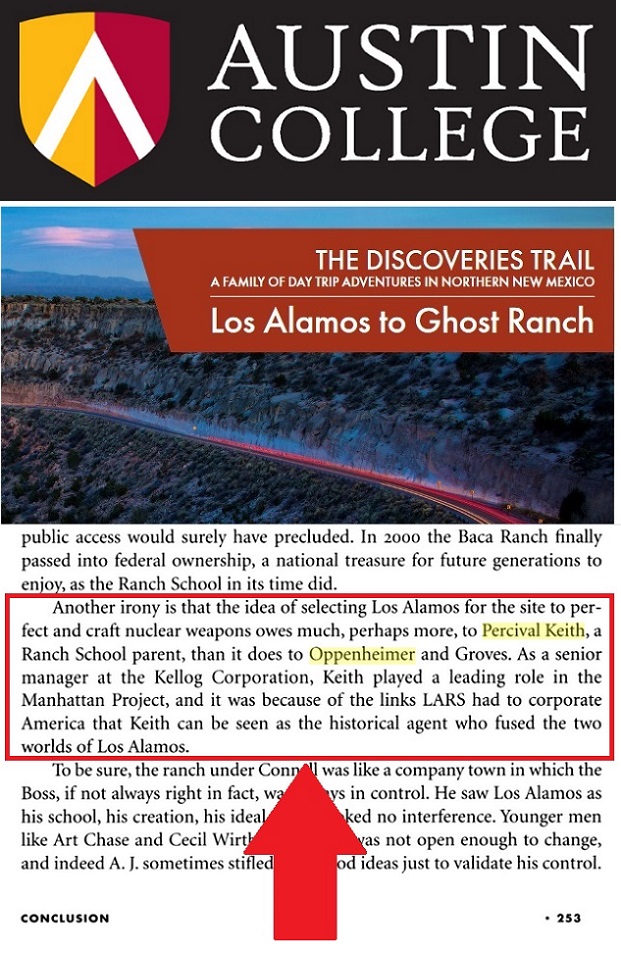
Saturday, July 15. Chapter 5: Los Alamos & Robert Oppenheimer
His name was Percival C. Keith. He was an Austin College Kangaroo. And alongside Robert Oppenheimer, he led America into the atomic age.
Ghost Ranch is a beloved Austin College experience. Many Kangaroos count a visit to the former home and studio of Georgia O’Keefe in central New Mexico as a highlight of their AC experience. Decades later, you’ll find AC grads waxing nostalgic about the place, as if Ghost Ranch were “Austin College West.” Percival Keith (AC ’19) was one.
While Percival C. Keith was busy developing the process to enrich uranium (U-235) fuel at Oak Ridge, Manhattan Project collaborators Leslie Groves (Matt Damon in “Oppenheimer”) and Robert Oppenheimer (Cillian Murphy in “Oppenheimer”) were scouting locations to design, develop, and construct the “gadget” the fuel would power. They needed somewhere isolated.
The location had to be far from the coasts, in case of attack from German & Japanese saboteurs. It had to be in a place far from the natural disasters of hurricanes, tornados, & floods. And it needed to be “in the middle of nowhere” so that testing could proceed without risk to civilian populations. Yet the spot needed enough infrastructure to accommodate a small town. In short, the Manhattan Project needed something resembling Ghost Ranch in New Mexico.
In trailer #2 of “Oppenheimer,” Robert Oppenheimer makes clear his motivation for securing an isolated location:
“We’ve got one hope. All of America’s industrial might and scientific innovation connected here, a secret laboratory. Keep everyone there until it’s done. Build a town, build it fast. If we don’t let scientists bring their families, we’ll never get the best.”
And Roo Percival C. Keith knew just the place in New Mexico for Oppenheimer & Groves: Los Alamos, which lies a mere 30 miles from Ghost Ranch.
After graduation from Austin College in 1919, Keith moved to the East Coast, married, and raised a family of boys. The Keith family sent their boys to the Los Alamos Ranch School (LARS) for boys during the summers of the 1930s. There at the school, the Keith boys could escape the city life of New York and enjoy all rural New Mexico had to offer. When Oppenheimer began to look for a location to build the A-bomb, it was Keith who suggested Los Alamos.
From the book “Los Alamos: The Ranch School Years, 1917-1943:”
“Another irony is that the idea of selecting Los Alamos for the site to perfect and craft nuclear weapons owes much, perhaps more, to Percival Keith, a Ranch School parent, than it does to Oppenheimer and Groves. As a senior manager at the Kellogg Corporation, Keith played a leading role in the Manhattan Project, and it was because of the links LARS (Los Alamos Ranch School) had to corporate America that Keith can be seen as the historical agent who fused the two worlds of Los Alamos.”
From Yvonne Delamater of the Los Alamos Historical Society:
“It is the Ranch School development that attracted the attention of both Robert Oppenheimer, Project Y’s director, and Percival C. Keith, a member of the planning board of the Office of Scientific Research and Development (OSRD), when the [Manhattan Project] was searching for a site. Both men believed the isolated school offered the necessary security and adequate housing for the project.”
The part of Percival Keith is not cast in the movie “Oppenheimer,” likely because Christopher Nolan chose Ernest Lawrence over Keith to represent America’s father of enriched uranium. But make no mistake. Not only was Keith indispensable in Oak Ridge for producing the fuel for Oppenheimer’s “gadget,” he is also responsible for selecting the location where Oppenheimer would build it.
Who knew? Somehow it’s true. Los Alamos National Laboratory is due to a Roo.
Despite not being cast, the presence of Keith will nevertheless be found throughout Nolan’s movie. Clues to look for from this chapter: Los Alamos, Los Alamos Ranch School, Summer Boys camp, and perhaps even the name Percival Keith itself.
Ghost Ranch in New Mexico is just a short drive from Santa Fe. To get there, take Highway 84 northwest. After 15 minutes, you’ll arrive at a fork in the road. One way will take you to the former estate of Georgia Keefe; the other will take you to Los Alamos National Laboratory. And if you are a Kangaroo, you can’t lose either way. For both Ghost Ranch & Los Alamos have strong ties to Austin College.
The full Roo Tale of Percival Keith will be told next Saturday; I’ll be watching the movie “Oppenheimer” one day later on Sunday. I can’t wait for the movie. After weeks of researching the Manhattan Project and writing about one Roo’s contribution, I’ll be enjoying it from start to finish. Hope you will as well, and hope these stories were helpful in doing so. The early reviews are already out, and the word on the street about the film is nearly unanimous: it is “spectacular.”
The movie “Oppenheimer” by Director Christopher Nolan will be released next week. Your Summer Roo Tale homework? Keep reading this “Oppenheimer” Roo Tale. Then watch the movie at a theatre near you. And remember: the Harry Truman Administration awarded “Medals for Merit” to eight scientists for “scientific distinction in connection with the development of the atomic bomb.” One of the eight scientists was Austin College Kangaroo Percival C. Keith. Another one of the eight was Dr. J. Robert Oppenheimer.
Saturday, June 10: Introduction
Saturday, June 17: Chicago & Enrico Fermi
Saturday, June 24: MIT & Vannevar Bush
Saturday, July 1: Manhattan & Leslie Groves
Saturday, July 8: Oak Ridge & Ernest Lawrence
Saturday, July 15: Los Alamos & Robert Oppenheimer
Saturday, July 22: The Percival C. Keith “Oppenheimer” Roo Tale
Sunday, July 23: The movie “Oppenheimer” opens nationwide. Go see it!
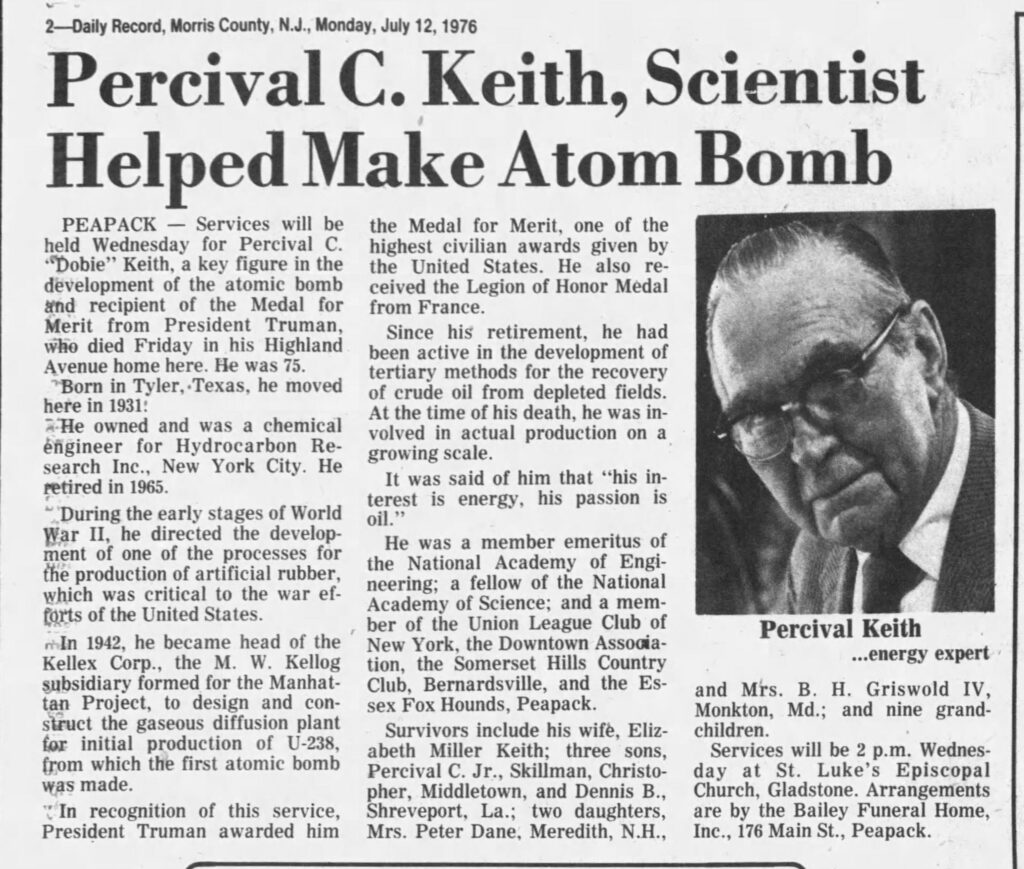
https://www.theguardian.com/film/2023/jul/12/oppenheimer-movie-reactions-christopher-nolan-release
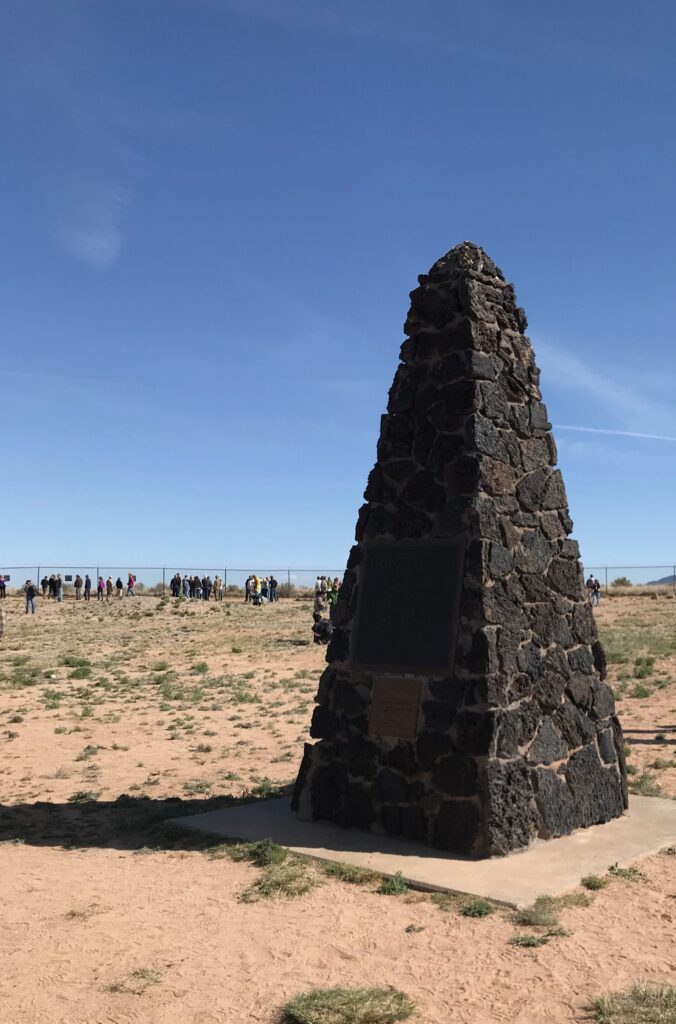
This Austin College post is all about Trinity.
The Trinity Test was the first atomic explosion in history. The test will be the “big moment” of Christopher Nolan’s blockbuster “Oppenheimer,” which opens this week. As you are all aware, after weeks of Percival Keith Roo Tale chapters, Marc has a little bit of Oppenheimer atomic fever.
Yesterday, the fabulous Roo Susan E. Stephens shared her visit to the Trinity test site in 2019. Why yesterday? Because yesterday was the 78th anniversary of the Trinity test. From her post, I learned that one can only visit the site twice a year (first Saturday in April & October). After the movie “Oppenheimer,” I suspect tickets will be an even tougher get.
You can still get tickets to the movie though. And if you live near Austin College or Trinity University, you can get tickets to a special theatre which will be displaying the film in all of its IMAX glory. Nolan filmed the movie on “70mm,” the highest quality imaging format ever created. Only 30 theatres worldwide (and only 2 in Texas) are equipped to display the Trinity test in the ridiculous size & clarity of 70mm:
Cinemark 17 & IMAX – Dallas (near IH35/IH635)
AMC Rivercenter 11 & IMAX – San Antonio (near Riverwalk)
There’s a new Oppenheimer trailer out this week which focuses on the Trinity test. See the comments. I also like the trailer because of an appearance by Josh Harnett (who plays Ernest Lawrence in “Oppenheimer”). Ernest Lawrence is the closest proxy to Kangaroo Percival Keith; both were tasked with refining uranium at Oak Ridge as Oppenheimer’s team did the design work at Los Alamos for the Trinity test. The Trinity test fuel came from Oak Ridge.
The last chapter of the Percival Keith “Oppenheimer” Roo Tale has been written. This final chapter focuses on Keith’s ties to Austin College, both as a student before the Manhattan Project and as an alum after the Trinity test. The last chapter will be shared on Saturday.
On Sunday, I’ll be watching the movie “Oppenheimer” with family in Austin. Nope, no incredible IMAX screen in Dallas or San Antonio for me. But no worries, we’re splurging on a fancy Austin IPIC theatre just the same. After weeks of writing about Oppenheimer, you better believe we’ll be sparing no expense for a great viewing of Nolan’s latest work…including “the moment” that is the Trinity test.
Yes indeed, Austin College (1849) & Trinity (1869) are historic Presbyterian rivals in the state of Texas. I don’t really have any beef with Trinity. You might even say that I’m an admirer or even a sometimes fan of that thriving school in San Antonio. But it’s probably also accurate to say that there would be no Trinity University without Austin College. And there probably would be no Trinity test without Austin College Kangaroo Percival Keith.

Saturday, July 22: The Percival C. Keith “Oppenheimer” Roo Tale
His name was Percival C. Keith. He was an Austin College Kangaroo. And alongside Robert Oppenheimer, he led America into the atomic age.
Percival Keith was born in Texas in 1900. A precocious kid, his parents moved to Sherman and enrolled Keith in Captain John Henry LeTellier’s “Select School.” LeTellier, a retired French engineering officer, was instrumental in developing Keith’s love of engineering.
Keith enrolled at Austin College at the tender age of 16. His major was English Literature. He was President of the Philennoian Literary Society, Captain of the Freshman Debating Team, President of the Sherman Club, a member of the AC tennis team, and Advertising Manager of the AC Chromascope.
Keith’s time on the Chromascope Staff was shared with some Roo heavy hitters: Athletic Director Ewell Walker, whose son Doak Walker would win the Heisman trophy. Business Manager Shem Cunningham, whose legacy today funds the AC Cunningham lectures. And Editor Homer Rainey, later President of the University of Texas and the namesake of the AC Homer Rainey Award.
In the 1919 Chromascope, Senior Kangaroos all enjoyed a “Who’s Who” write up before their graduation from Austin College. Keith’s write up was a premonition of his energy future to come:
“Influenza has been attributed to the gases blown over from Europe but we wonder if Percy [Keith] couldn’t be responsible? Those of you who have heard him orate or debate will substantiate such an assertion. Of all the assorted mixtures that ever struck the campus, Percy [Keith] is the chief. At times he has enough ENERGY to explode a powder mine.”
Percival Keith graduated from Austin College in 1919 and chose a path which led him to the Manhattan Project. He enrolled at MIT in 1919, where he studied under Manhattan Project participants Warren Lewis & Vannevar Bush (Matthew Modine in “Oppenheimer”). He worked for the Kellogg Corporation in Manhattan, where he teamed with Leslie Groves (Matt Damon in “Oppenheimer”) to form the secret subsidiary Kellex to master the refinement of uranium. He collaborated with Ernest Lawrence (Josh Harnett in “Oppenheimer”) to refine uranium at the now nationally famous facility Oak Ridge. And he suggested the site of Los Alamos to Robert Oppenheimer (Cillian Murphy in “Oppenheimer”) for the design and successful test of his “gadget” at a place called Trinity. That path has been covered extensively in prior chapters this summer.
Christopher Nolan’s blockbuster “Oppenheimer” opens this weekend. The part of Kangaroo Percival Keith is not cast, likely because Christopher Nolan chose Ernest Lawrence over Keith to represent America’s father of enriched uranium. But make no mistake, Keith was as indispensable to the success of the project as Bush, Groves, Lawrence, and Oppenheimer himself. Despite not being cast, the presence of Keith will nevertheless be found throughout Nolan’s movie. This Roo Tale has provided Kangaroos who have read with all of the clues.
Percival Keith’s work was worthy of a New York Times obituary, which he got after his passing in July of 1976:
“Percival Cleveland Keith, construction chief of the atomic bomb plant at Oak Ridge, TN, died at his home in Peapack, NJ. He was 75 years old. For his work on the Oak Ridge part of the Manhattan Project, the War Department cited Mr. Keith in 1946 for ‘brilliant accomplishments involving grave responsibility and technical administrative ability in connection with the development of the greatest weapon of all time, the atomic bomb.’ The citation hailed his ‘rare technical ability, his initiative and resourcefulness, his exceptional capacity as an executive and his inspiriting devotion to duty.’”
“Born in Tyler, TX, Mr. Keith graduated from Austin College in Sherman, TX, and later did graduate work at the Massachusetts Institute of Technology. [Keith] played a major role in the design and construction of the gas diffusion plant for the separation [enrichment] of uranium-235. He was known to his friends as ‘the red-faced, hurry-up man who bossed the construction of the famed atom bomb plant at Oak Ridge.’”
The Atomic Heritage Foundation tells the story of the Manhattan Project, and the “Leadership” behind the project’s success. Just like his contemporaries on the AC Chromascope staff, Roo Percival Keith is listed right beside all the heavy hitters who are cast in Christopher Nolan’s “Oppenheimer”:
“The Manhattan Project benefited from an unusual number of extremely intelligent, experienced, and effective leaders. Their enormous energy and undaunted spirit carried the project forward despite the odds against its success. Some of these exemplary leaders included the Army Corps of Engineers’ General Leslie Groves, physicists J. Robert Oppenheimer and Enrico Fermi, DuPont’s Crawford Greenewalt, Kellogg’s Percival Keith, MIT’s Vannevar Bush, Harvard’s James B. Conant, and Berkeley’s Ernest O. Lawrence.
In March of 1946, the Truman Administration presented eight scientists with the Medal of Merit for ‘scientific distinction’ in connection with their work on the Manhattan Project. One of those eight was the topic of this summer’s blockbuster. Another of the eight was a Roo:
- Dr. Robert J. Oppenheimer, California Institute of Technology, who was director of the atomic bomb project laboratory in New Mexico.
- Percival Cleveland Keith, Hydro-Carbon Research Inc., New York City, who designed the gas diffusion plan for the separation of uranium.
Percival Keith was a busy man in the spring of 1946. After his recognition by President Harry Truman in March, Keith accepted an invitation in April to speak at the May 1946 Commencement of his alma mater Austin College. Keith arrived in Sherman that May to speak on all manner of topics that did NOT include the top secret project in which he had recently participated.
No mention of Keith’s collaboration with Oppenheimer was made at the 1946 AC graduation. The Kangaroo newspaper didn’t know, AC administration and faculty were unaware, the student body to which Keith spoke was in the dark, and Percival Keith himself didn’t mention his work in his address. Which makes sense given the national security implications of his work. To paraphrase from the movie “Fight Club:”
“The first rule of a Kangaroo-driven Manhattan Project? Nobody talks about a Kangaroo-driven Manhattan Project.”
I was a member of the first place Austin College delegation to the National Model United Nations (NMUN) in New York back in 1990. Led by Dr. Shelton Williams, a member of the Nuclear Regulatory Commission (a successor agency to Oppenheimer’s Atomic Energy Commission), AC represented the United States of America. My team was tasked with defending U.S. Policy on the Non-Proliferation Treaty (NPT). The NPT has two goals: (1) commit the five official nuclear weapon states (US, USSR/Russia, UK, France, China) to stable and verified nuclear arsenals while (2) guaranteeing non-nuclear weapon states access to nuclear energy for peaceful purpose.
Our work in the post-Cold War environment of 1990 was one of optimism, as the world was rapidly moving towards both goals. Today’s environment, however, is different. With nuclear exchanges a concern in the Ukraine & the Taiwan straits as the world recklessly hurdles past the 400ppm carbon threshold, a stable regulatory regime for carbon-free energy across the planet looks more important than ever. Percival Keith’s engineering gave us the tools to make it happen; only politics and human nature stand in the way.
My family will be watching the movie “Oppenheimer” tomorrow. Needless to say, this summer’s Roo research and writing about the Manhattan Project has made me very excited to take it all in. Yes, I’ll be hoping for any fleeting reference to Kangaroo Percival Keith. But even if Keith does not make an appearance, I’m grateful that my knowledge of the Manhattan Project has increased by an order of magnitude like an atomic reaction. Writing this Roo Tale has made the Christopher Nolan movie a highlight of my summer of 2023.
Hope you enjoyed. Now go see Oppenheimer! And leave your movie reviews for me to read. Until the next one, thanks everybody.

